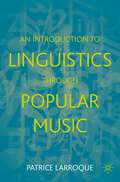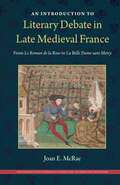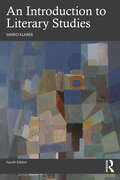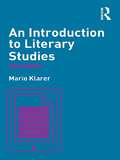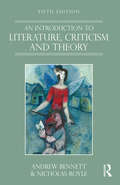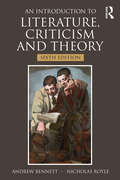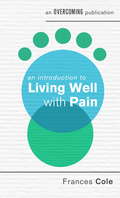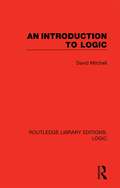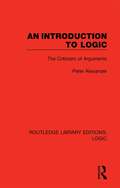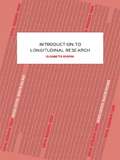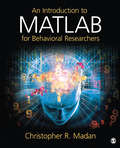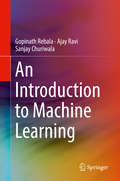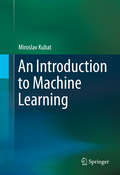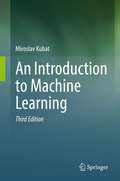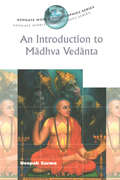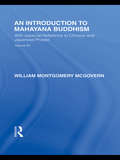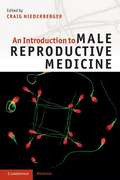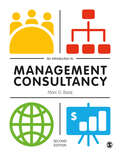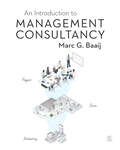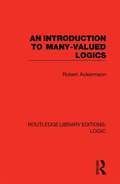- Table View
- List View
An Introduction to Linguistics through Popular Music
by Patrice LarroqueThis textbook introduces the field of linguistics, demonstrating syntactic categories, morphological structures, phonological/metric structures, syllable structures, and varieties of English in an accessible way by using portions of song lyrics from popular music. The varieties of English covered include Received Pronunciation (RP) and General American, as well as some features of Australian English, southern US varieties, and Scottish English. Drawing on shared characteristics between language and music, including metrical structure, the author suggests a different approach to linguistic analysis and the description of spoken language. The book introduces both students and instructors to a novel and engaging method of description, and provides a fresh vocabulary with which to start thinking about language. It demonstrates complex topics by using music as a fun and familiar starting point, and will be an ideal resource for introductory linguistics courses worldwide.
An Introduction to Literary Debate in Late Medieval France: From Le Roman de la Rose to La Belle Dame sans Mercy (New Perspectives on Medieval Literature: Authors and Traditions)
by Joan E. McRaeHow medieval poems sparked discussions on women’s agency, love, marriage, and honor that prefigured modern feminism This volume immerses readers in a debate tradition that flourished in France during the late Middle Ages, focusing on two works that were both popular and controversial in their time: Le Roman de la Rose by thirteenth-century poets Guillaume de Lorris and Jean de Meun and La Belle Dame sans Mercy by fifteenth-century royal secretary and poet Alain Chartier. This is the first comparative volume on these important works and the discussions they sparked. Engaging with questions of women’s agency, love, marriage, and honor, these two poems prompted responses that circulated via treatises, letters, and sermons among officials, clerics, and poets. Joan McRae provides commentary on the two texts, a timeline and summary of the resulting debates, and biographical sketches of the leading intellectuals who matched wits over different ways of reading the texts, including pioneering writer Christine de Pizan. McRae shows that these works and the debates, read together, consider a range of social issues that raise questions of gender, the place of power and hierarchy in societal relationships, and the responsibility of writers for the effect of their works on readers. An Introduction to Literary Debate in Late Medieval France is a helpful overview of these weighty arguments for both students and scholars. McRae provides a compact, comprehensive, and up-to-date study, spotlighting influential literary expressions that evolved into the “querelle des femmes,” the “woman question,” which in turn paved the way for modern feminism. A volume in the series New Perspectives on Medieval Literature: Authors and Traditions, edited by R. Barton Palmer and Tison Pugh
An Introduction to Literary Studies
by Mario KlarerThe fourth edition of this classic beginner’s guide to literary studies has been fully updated throughout. Mario Klarer offers a concise and accessible discussion of central issues in English and world literature as well as film and television series. Starting with the basics of what constitutes a literary text, the book moves through an analysis of major genres, important periods, and key theoretical approaches to literature and film. It also looks at the practicalities of finding and referencing secondary sources when writing a research paper. The expanded new edition has been updated to include: a wider range of examples from world literature, cinema, and television series additional references to contemporary streaming formats updated chapters on postcolonial theory, cultural studies, gender theory, feminism, and queer theory new sections on digital humanities, ecocriticism, literary translations, and paratexts extended explanations of traditional genres, e.g., the epic, drama, and poetry a completely revised chapter on the most recent MLA guidelines with rules for citing new media formats The detailed glossary ensures that the book is accessible to readers of any level, making this an ideal self-study guide or a course book for Introduction to Literature classes.
An Introduction to Literary Studies
by Mario KlarerIn this classic beginner's guide to English literature, Mario Klarer offers a concise and accessible discussion of central issues in the study of literary texts, looking at: definitions of key terms such as literature and text the genres of fiction, poetry, drama, and film periods and classifications of literature theoretical approaches to texts the use of secondary resources guidelines for writing research essays The new and expanded edition is fully updated to include: a wider range of textual examples from world literature additional references to contemporary cinema, a section on comparative literature an extended survey of literary periods and genres recent changes in MLA guidelines information on state-of-the-art citation management software the use and abuse of online resources. The book also features suggestions for further reading as well as an extensive glossary of key terms.
An Introduction to Literature and the Fine Arts
by The Editors at Michigan State College PressA collaborative study of the arts of literature, music, sculpture, architecture, and painting in the development of the Western tradition.
An Introduction to Literature, Criticism and Theory
by Andrew Bennett Nicholas RoyleLively, original and highly readable, An Introduction to Literature, Criticism and Theory is the essential guide to literary studies. Starting at ‘The Beginning’ and concluding with ‘The End’, chapters range from the familiar, such as ‘Character’, ‘Narrative’ and ‘The Author’, to the more unusual, such as ‘Secrets’, ‘Pleasure’ and ‘Ghosts’. Now in its fifth edition, Bennett and Royle’s classic textbook successfully illuminates complex ideas by engaging directly with literary works, so that a reading of Jane Eyre opens up ways of thinking about racial difference, for example, while Chaucer, Raymond Chandler and Monty Python are all invoked in a discussion of literature and laughter. The fifth edition has been revised throughout and includes four new chapters – ‘Feelings’, ‘Wounds’, ‘Body’ and ‘Love’ – to incorporate exciting recent developments in literary studies. In addition to further reading sections at the end of each chapter, the book contains a comprehensive bibliography and a glossary of key literary terms. A breath of fresh air in a field that can often seem dry and dauntingly theoretical, this book will open the reader’s eyes to the exhilarating possibilities of reading and studying literature.
An Introduction to Literature, Criticism and Theory
by Andrew Bennett Nicholas RoyleLively, original and highly readable, An Introduction to Literature, Criticism and Theory is the essential guide to literary studies. Starting at ‘The Beginning’ and concluding with ‘The End’, chapters range from the familiar, such as ‘Character’, ‘Narrative’ and ‘The Author’, to the more unusual, such as ‘Secrets’, ‘Pleasure’ and ‘Ghosts’. Now in its sixth edition, Bennett and Royle’s classic textbook successfully illuminates complex ideas by engaging directly with literary works, so that a reading of Jane Eyre opens up ways of thinking about racial difference, for example, while Chaucer, Monty Python and Hilary Mantel are all invoked in a discussion of literature and laughter. The sixth edition has been revised and updated throughout. In addition, four new chapters – ‘Literature’, ‘Loss’, ‘Human’ and ‘Migrant’ – engage with exciting recent developments in literary studies. As well as fully up-to-date further reading sections at the end of each chapter, the book contains a comprehensive bibliography and an invaluable glossary of key literary terms. A breath of fresh air in a field that can often seem dry and dauntingly theoretical, this book will open the reader’s eyes to the exhilarating possibilities of reading and studying literature.
An Introduction to Living Well with Pain (An Introduction to Coping series)
by Dr. Frances ColePractical 'footsteps' to help you live well with a chronic pain conditionIf you live with a long term condition that causes you chronic pain, then you are not alone. Chronic or persistent pain affects many adults and children in many ways. It can impact on your mood, your home and work life, your relationships, your sleep, your activities and all areas of your health. It can take your life over. Change is possible. Effective pain management requires a practical multi-focused approach. This self-help guide brings together tools that have worked with thousands of people with pain. It guides you through skills that help you stop struggling and cope well with pain, including:· Goal-setting, making action plans and rewarding yourself· Pacing your day to day activities and building in relaxation practice· Developing healthy exercise and eating routines· Sleeping well again· Coping with setbacks
An Introduction to Logic (Routledge Library Editions: Logic)
by David MitchellOriginally published in 1967. The common aim of all logical enquiry is to discover and analyse correctly the forms of valid argument. In this book concise expositions of traditional, Aristotelian logic and of modern systems of propositional and predicative logic show how far that aim has been achieved.
An Introduction to Logic: The Criticism of Arguments (Routledge Library Editions: Logic)
by Peter AlexanderOriginally published in 1969. This book is for undergraduates whether specializing in philosophy or not. It assumes no previous knowledge of logic but aims to show how logical notions arise from, or are abstracted from, everyday discourse, whether technical or non-technical. It sets out a knowledge of principles and, while not historical, gives an account of the reasons for which modern systems have emerged from the traditional syllogistic logic, demonstrating how certain central ideas have developed. The text explains the connections between everyday reasoning and formal logic and works up to a brief sketch of systems of propositional calculus and predicate-calculus, using both the axiomatic method and the method of natural deduction. It provides a self-contained introduction but for those who intend to study the subject further it contains many suggestions and a sound basis for more advanced study.
An Introduction to Longitudinal Research (Social Research Today)
by Elisabetta RuspiniOne of the major changes in the social science research landscape in recent years has been the introduction of computerised panel surveys in Europe and the US which make longitudinal data widely available to graduate students for the first time. Elisabetta Ruspini here provides a concise yet comprehensive introduction to the issues involved in this kind of research. This book:* Defines the concept of longitudinal research* Gives guidance on sources of longitudinal data in Europe and the US and their strengths and weaknesses* Discusses the choices that need to be made in this kind of research - for instance the advantages and disadvantages of certain types of research data and of different types of analysis* Highlights some of the problems involved, e.g. the issue of comparability within longitudinal research
An Introduction to MATLAB for Behavioral Researchers
by Christopher R. MadanMATLAB is a powerful data analysis program, but many behavioral science researchers find it too daunting to learn and use. An Introduction to MATLAB for Behavioral Researchers by Christopher R. Madan is an easy-to-understand, hands-on guide for behavioral researchers who have no prior programming experience. Written in a conversational and non-intimidating style, the author walks students—step by step—through analyzing real experimental data. Topics covered include the basics of programming, the implementation of simple behavioral analyses, and how to make publication-ready figures. More advanced topics such as pseudo-randomization of trial sequences to meet specified criteria and working with psycholinguistic data are also covered. Interesting behavioral science examples and datasets from published studies, such as visualizing fixation patterns in eye-tracking studies and animal search behavior in two-dimensional space, help develop an intuition for data analysis, which is essential and can only be developed when working with real research problems and real data.
An Introduction to Machine Learning
by Sanjay Churiwala Gopinath Rebala Ajay RaviJust like electricity, Machine Learning will revolutionize our life in many ways – some of which are not even conceivable today. This book provides a thorough conceptual understanding of Machine Learning techniques and algorithms. Many of the mathematical concepts are explained in an intuitive manner. The book starts with an overview of machine learning and the underlying Mathematical and Statistical concepts before moving onto machine learning topics. It gradually builds up the depth, covering many of the present day machine learning algorithms, ending in Deep Learning and Reinforcement Learning algorithms. The book also covers some of the popular Machine Learning applications. The material in this book is agnostic to any specific programming language or hardware so that readers can try these concepts on whichever platforms they are already familiar with. Offers a comprehensive introduction to Machine Learning, while not assuming any prior knowledge of the topic;Provides a complete overview of available techniques and algorithms in conceptual terms, covering various application domains of machine learning;Not tied to any specific software language or hardware implementation.
An Introduction to Machine Learning
by Miroslav KubatThis book presents basic ideas of machine learning in a way that is easy to understand, by providing hands-on practical advice, using simple examples, and motivating students with discussions of interesting applications. The main topics include Bayesian classifiers, nearest-neighbor classifiers, linear and polynomial classifiers, decision trees, neural networks, and support vector machines. Later chapters show how to combine these simple tools by way of "boosting," how to exploit them in more complicated domains, and how to deal with diverse advanced practical issues. One chapter is dedicated to the popular genetic algorithms.
An Introduction to Machine Learning
by Miroslav KubatThis book presents basic ideas of machine learning in a way that is easy to understand, by providing hands-on practical advice, using simple examples, and motivating students with discussions of interesting applications. The main topics include Bayesian classifiers, nearest-neighbor classifiers, linear and polynomial classifiers, decision trees, neural networks, and support vector machines. Later chapters show how to combine these simple tools by way of "boosting," how to exploit them in more complicated domains, and how to deal with diverse advanced practical issues. One chapter is dedicated to the popular genetic algorithms.
An Introduction to Machine Learning
by Miroslav KubatThis textbook offers a comprehensive introduction to Machine Learning techniques and algorithms. This Third Edition covers newer approaches that have become highly topical, including deep learning, and auto-encoding, introductory information about temporal learning and hidden Markov models, and a much more detailed treatment of reinforcement learning. The book is written in an easy-to-understand manner with many examples and pictures, and with a lot of practical advice and discussions of simple applications. The main topics include Bayesian classifiers, nearest-neighbor classifiers, linear and polynomial classifiers, decision trees, rule-induction programs, artificial neural networks, support vector machines, boosting algorithms, unsupervised learning (including Kohonen networks and auto-encoding), deep learning, reinforcement learning, temporal learning (including long short-term memory), hidden Markov models, and the genetic algorithm. Special attention is devoted to performance evaluation, statistical assessment, and to many practical issues ranging from feature selection and feature construction to bias, context, multi-label domains, and the problem of imbalanced classes.
An Introduction to Macroscopic Quantum Phenomena and Quantum Dissipation
by Amir O. CaldeiraReviewing macroscopic quantum phenomena and quantum dissipation, from the phenomenology of magnetism and superconductivity to the presentation of alternative models for quantum dissipation, this book develops the basic material necessary to understand the quantum dynamics of macroscopic variables. Macroscopic quantum phenomena are presented through several examples in magnetism and superconductivity, developed from general phenomenological approaches to each area. Dissipation naturally plays an important role in these phenomena, and therefore semi-empirical models for quantum dissipation are introduced and applied to the study of a few important quantum mechanical effects. The book also discusses the relevance of macroscopic quantum phenomena to the control of meso- or nanoscopic devices, particularly those with potential applications in quantum computation or quantum information. It is ideal for graduate students and researchers.
An Introduction to Madhva Vedanta (Ashgate World Philosophies Series)
by Deepak SarmaThis introduction to the Madhva school of Vedanta is accessible to a wide audience with interest in Hinduism, Indian thought and in the comparative philosophy of religion. Deepak Sarma explores the philosophical foundations of Madhva Vedanta and then presents translations of actual debates between the Madhva and Advaita schools of Vedanta, thus positioning readers at the centre of the 700 year-old controversy between these two schools of Vedanta. Original texts of Madhvacarya are included in an appendix, in translation and in Sanskrit.
An Introduction to Magic: A Guide to Crystals, Fairies, Palmistry, Tarot, and the Zodiac
by Nikki Van De Car Mikaila Adriance Pliny T. Young Eugene FletcherBegin your magical practice with this beautifully illustrated introduction to crystals, the zodiac, tarot, palmistry, and fairies. Start an exploration of some of the most popular mystical topics with An Introduction to Magic! This accessible primer brings together everything you need to know to begin a magical practice, with chapters on crystals, astrology, tarot, palm reading, and fairies from around the world. Learn the meaning and healing properties of the most common magic crystals; the basics of the zodiac signs; the meaning of the Major and Minor Arcana of the tarot; how to conduct a palm reading; and the stories behind popular global fairies. Each chapter is written by a seasoned expert and features stunning illustrations tailored to the topic, to enhance your reading experience.
An Introduction to Mahāyāna Buddhism: With especial Reference to Chinese and Japanese Phases (Routledge Library Editions: Japan)
by William M McGovernWilliam Montgomery McGovern’s Introduction to Mahayana Buddhism was one of the first books on Mahayana Buddhism written for a Western audience. It predates influential English language overviews of Buddhism by D. T. Suzuki, A. Watts, and W. Rahula. The author was born in New York City in 1897 and spent his latter teenage years (1914-1917) training at the Nishi Hongwanji Mahayana Buddhist monastery in Kyoto, Japan. He founded the Mahayana Association at age eighteen and edited and published the journal "Mahayanist" while completing his studies at the monastery. Introduction to Mahayana Buddhism was written as part of a thesis which secured him his Buddhist degree and an honorary ordination as a Buddhist priest. Intended as a simplified and introductory text for a lay audience, the book reflects the unique perspective of a Westerner trained in Japan at a time when Mahayana Buddhism was little known in the West. Referencing Buddhist literature, it gives a short history of Buddhism and the divergence of schools of Buddhist philosophy, introduces the four noble truths, the philosophy of Karma, the nature of Buddhahood, reincarnation and the road to nirvana, Buddhist cosmology, and psychological and philosophical elements of Buddhist teachings. Although the divisions of non Mahayana Buddhist sects and philosophy described may be considered dated, Introduction to Mahayana Buddhism remains significant for its historical value in presenting Eastern religious and philosophical thought to Westerners at a pivotal time in history.
An Introduction to Male Reproductive Medicine
by Craig NiederbergerAn Introduction to Male Reproductive Medicine is written specifically for readers seeking entry into this fast-moving, complex specialty with a solid understanding of the subject. The first chapters cover the anatomy and physiology, clinical evaluation, surgery, medicine, genetics and laboratory testing involved in the current evaluation and treatment of the infertile male, and the final chapter describes the interaction of the field with female reproductive medicine. Throughout the book, references are directly made to the fourth edition of the major text in the specialty, Infertility in the Male, edited by Larry Lipshultz, Stuart Howards and Craig Niederberger, allowing readers to expand their understanding of specific areas where desired. Each chapter is written by a well-renowned expert in an easy to follow, informal style, making the text ideal for students, residents and general physicians who are seeking to increase their general knowledge of the field.
An Introduction to Management Consultancy
by Marc G. BaaijWhether you are preparing for a management consultancy career or only want to acquire widely applicable consultancy skills, you will need a clear and concise introduction to this area. This fully updated second edition text provides you with a practical, step-by-step guide to learn the proven successful methods and techniques of the world′s leading management consultancy firms. Detailed descriptions and real-life illustrations enable you to develop consultancy skills for structured problem-solving, critical thinking, collaboration and communication. Additionally, this text provides rich insights into the latest developments in the consultancy industry and their firms. It includes alumnus of a top management consultancy firm and is essential reading for aspiring consultants as well as anyone dealing with consultants in their career.
An Introduction to Management Consultancy
by Marc G. BaaijWhether you are preparing for a management consultancy career or only want to acquire widely applicable consultancy skills, you will need a clear and concise introduction to this area. This fully updated second edition text provides you with a practical, step-by-step guide to learn the proven successful methods and techniques of the world′s leading management consultancy firms. Detailed descriptions and real-life illustrations enable you to develop consultancy skills for structured problem-solving, critical thinking, collaboration and communication. Additionally, this text provides rich insights into the latest developments in the consultancy industry and their firms. It includes alumnus of a top management consultancy firm and is essential reading for aspiring consultants as well as anyone dealing with consultants in their career.
An Introduction to Management Consultancy
by Marc G. BaaijWhether you are looking to build on your management studies or experience of working in business, you are likely to have come across management consultancy and will need a clear and concise introduction to this area to help you understand its practices and techniques in order to hire and implement management consultancy in the future. This text provides you with these essentials for success in your studies and later industries when working with and not just for consultancy firms. The text is built around learning objectives to empower your understanding of the 'what', 'how', 'when' and 'why' at macro and micro levels of management consultancy and its stakeholders, and provides you with engaging real life examples and extra web materials for study. As well as full courses on management consultancy, this text will be invaluable to your management knowledge and skill-set across strategy, change, analytics, problem-solving, solution implementation and decision-making as applied by the world's top management consulting firms, such as McKinsey & Company, The Boston Consulting Group, and Bain & Company. Visit the companion website www.sagepub.co.uk/baaij Lecturer's resources Lecturer's guide Teaching notes per chapter Answer guidance to end-of-chapter questions in book Suggested discussion questions Suggested small group assignments Suggested small group field project Lecture slides Option 1: provide all figures of the book on PowerPoint slides Option 2: create complete PowerPoint presentations for each chapter Exercises Exam questions Discussion forum Student resources Templates for developing logical structures Web resources Consultancy publications Consultancy web site, career page Job application preparation services Consultancy institutions
An Introduction to Many-valued Logics (Routledge Library Editions: Logic)
by Robert AckermannOriginally published in 1967. An introduction to the literature of nonstandard logic, in particular to those nonstandard logics known as many-valued logics. Part I expounds and discusses implicational calculi, modal logics and many-valued logics and their associated calculi. Part II considers the detailed development of various many-valued calculi, and some of the important metathereoms which have been proved for them. Applications of the calculi to problems in the philosophy are also surveyed. This work combines criticism with exposition to form a comprehensive but concise survey of the field.
